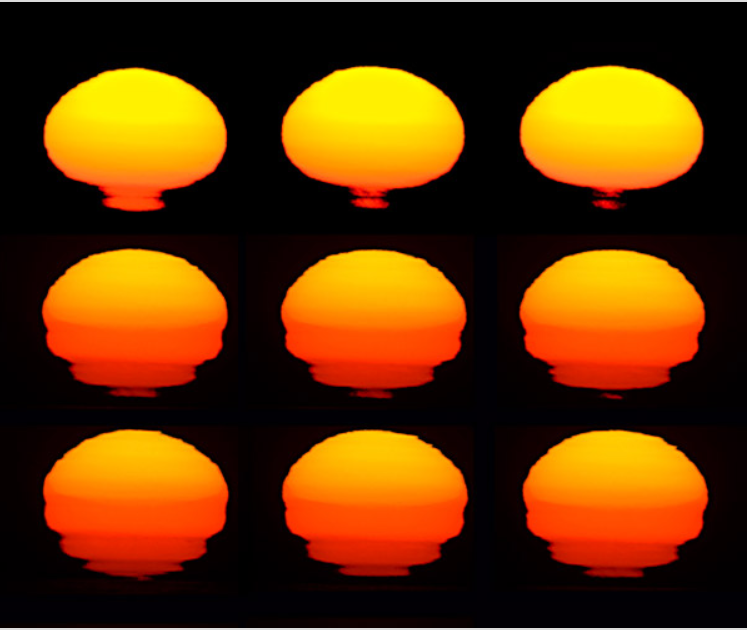Sunset Mirages
Sunset Mirages: A Fascinating Atmospheric Phenomenon
Sunset mirages are captivating optical illusions that occur when the low slanting rays of the sun are refracted between air layers of different temperatures. While we often observe a slightly flattened sun during normal sunsets, mirages require more severe temperature variations in the atmosphere. These mirages manifest as two or more images of the sun, creating a mesmerizing spectacle for onlookers.
One type of sunset mirage, known as M-Mir sunsets, occurs when there is a temperature inversion in the atmosphere. In this phenomenon, warm air overlays cooler layers, leading to the formation of multiple inversions. These inversions cause the sun's rays to bend and create distorted images of the sun, resulting in a mirage.
Another intriguing form of sunset mirage, described by Jules Verne as an "Etruscan vase," occurs when the sun-warmed afternoon sea generates an abnormally hot air layer just above its surface. This hot air layer then acts as a refracting medium, causing the sun to appear distorted and creating a visually stunning mirage.
One exciting aspect of miraged sunsets is their connection to the elusive green flash. The green flash is a rare phenomenon that sometimes occurs during the last moments of sunset or sunrise when atmospheric conditions are just right. It appears as a brief green spot or flash above the upper rim of the sun as it dips below the horizon. Miraged suns often precede the occurrence of the green flash, adding to their allure and making them even more captivating for skywatchers.
To fully appreciate sunset mirages and increase your chances of witnessing these breathtaking optical illusions, it is essential to understand the atmospheric conditions that contribute to their formation. Temperature inversions, where warmer air layers overlay cooler ones, play a crucial role in creating mirages. These inversions can occur due to various factors such as atmospheric stability, wind patterns, and the presence of specific geographic features.
During sunset, as the sun's rays pass through the atmosphere, they encounter these temperature inversions, causing them to refract and bend. The bending of light rays leads to the formation of multiple images of the sun, resulting in the mirage. The severity and complexity of the mirage depend on the number and intensity of the temperature inversions present in the atmosphere.
The phenomenon of sunset mirages is not limited to specific geographical locations. They can occur in various parts of the world where the necessary atmospheric conditions align. However, coastal regions are often more conducive to the formation of sunset mirages due to the presence of large water bodies, which can contribute to temperature inversions and create the ideal conditions for mirages to occur.
Witnessing a sunset mirage is a truly awe-inspiring experience. The distorted images of the sun, appearing like shimmering reflections or ethereal apparitions, create a surreal and magical atmosphere. These optical illusions serve as a reminder of the fascinating and ever-changing nature of our atmosphere, offering a glimpse into the intricacies of light and atmospheric phenomena.
In conclusion, sunset mirages are captivating atmospheric phenomena that occur when the sun's rays are refracted between air layers of different temperatures. These optical illusions can take various forms, such as multiple inversions or distorted sun images caused by abnormally hot air layers near the sea's surface. Sunset mirages often precede the occurrence of the elusive green flash, adding to their allure. By understanding the atmospheric conditions that contribute to their formation, we can increase our chances of witnessing these mesmerizing events and appreciate the wonders of our dynamic atmosphere.

Mirages occur at sunrise too. Sunrise mirage sequence captured over Casco Bay, Cape Elizabeth, Maine by John Stetson ©John Stetson shown with permission
Sunset mirages, two or more images of the sun, are seen when its low slanting rays are unusually refracted between air layers of different temperature.
Usually the air temperature falls smoothly with increasing height. The most we then see is a slightly flattened sun. A mirage needs more severe temperature variations.
One class of mirages, M-Mir sunsets,occur when there is a temperatureinversion – warm air overlays cooler layers.
The sunset mirage at left was produced by multiple inversions.
Another sunset mirage form, Jules Verne called it an “Etruscan vase”, occurs when the sun-warmed afternoon sea produces an abnormally hot air layer close above its surface.
Miraged suns often presage the elusive green flash!
Note: this article has been automatically converted from the old site and may not appear as intended. You can find the original article here.
Reference Atmospheric Optics
If you use any of the definitions, information, or data presented on Atmospheric Optics, please copy the link or reference below to properly credit us as the reference source. Thank you!
-
<a href="https://atoptics.co.uk/blog/sunset-mirages/">Sunset Mirages</a>
-
"Sunset Mirages". Atmospheric Optics. Accessed on April 27, 2024. https://atoptics.co.uk/blog/sunset-mirages/.
-
"Sunset Mirages". Atmospheric Optics, https://atoptics.co.uk/blog/sunset-mirages/. Accessed 27 April, 2024
-
Sunset Mirages. Atmospheric Optics. Retrieved from https://atoptics.co.uk/blog/sunset-mirages/.